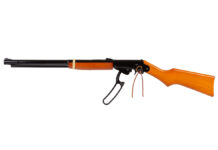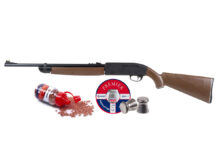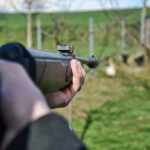Now that whitetail season is over, a lot of hunters will be heading out to chase coyotes so they can pass time until spring. Just like with deer hunting, there will be some guys who get really hardcore, but the majority of the folks in the field will be your average Joe schmo. There is nothing wrong with that, but it does mean your success will depend on how you hunt.

Covering lots of ground this time of year will be your best strategy in the woods.
Often times you will see an electronic call on top of a pickup with guys standing around the truck. While this may sometimes work for them, a blind squirrel finds a nut every once in a while, and if your goals are higher than a couple chances every year, you will need to put some miles on the boots. My favorite setups are crick/river bottoms. Coyotes love traversing across frozen bodies of water as they can see distances and travel is relatively easy.

In this setup, we are blowing our call across the open water and anticipating a coyote to circle in between us and the water’s edge.
When you first set up, try doing some sort of a lip squeak or mouse squeak. If you’re walking quietly, you could surprise yourself on how close you can set up. If nothing comes in, use a variation of a coyote locator howl, and then transition to a prey distress call. Probably the most common distress call is a cottontail in distress. This call can be a great sequence to pull in curious song dogs, but it may also not work on some high-pressure areas. My favorite distress call to use is a woodpecker in distress. You can learn how to do this call on a softer open reed with a little practice, and it is also found on most electronic calls.
At this point, if you haven’t enticed anything in, switch it up and go with a fox or raccoon fight followed by a coyote distress call (usually some sort of pup distress). The goal here is to paint the picture that a young coyote came in to the dinner bell, and now is getting his butt kicked by an angry fox or raccoon.

Learning to call with an open reed will give you more variation and life-like calling sequences.
After your last call, wait for 10-15 minutes and keep your eyes peeled. Just like turkeys, some coyotes will come screaming in to the call, and some will sneak in without a noise. Those aggressive screamers would have likely already come in, but the ones who are going to tip toe in will pop up now. If you’re not on your toes, these wary responders may bust you quickly, or get too close for you to move before you have a chance to get your weapon on them.
Now, there’s a couple of very important things to keep in mind before you start your vehicle and grab your gun.
- Wind is everything. Coyotes will almost ALWAYS circle downwind of where they hear the calling from. You can use that to your advantage and setup where you can predict them to circle. Fence lines, drop-offs, water dams, frozen bodies of water, etc, are all good travel routes, and you can also use factors like open bodies of water to pinch down the distance a coyote can circle away from you. The goal here is to get coyotes to circle as close as possible to you, and then take your shot before they get down wind.
- Blend in. Coyotes can see very well. If there’s snow on the ground, you will stick out like a sore thumb in an open area with regular camo on. Snow camo bibs and a coat are a good idea, but if you’re on a budget, a couple of white bedsheets can definitely do the trick with some redneck ingenuity.
- Stay mobile. Try to stay around the half hour mark with each setup. Wait a few minutes between each different call in your setup, and make sure you give coyotes enough time to come in, but don’t make the mistake of staying in one spot too long. Covering a lot of ground will be the most crucial factor to your success.
- HAVE FUN. It will be cold and windy, and you will probably be walking a lot, but we are supposed to have fun and enjoy being outdoors. Hunting shouldn’t be a grind. If it gets to that point, you will burn out quickly, and your success will plummet.
Can’t get enough coyote hunting content? Checkout our podcast Calling all Coyotes. Looking for some tips on improving your rifle accuracy? Checkout our blog series on Why You Missed that Deer.
Photos by Ted Zangerle
It’s our hope you can learn and laugh along with the expert voices we feature on this blog. We want to be clear that the opinions you see featured here are just that: opinions. The content belongs to the authors and is not necessarily the opinion of Vortex Optics.
To learn more about what you’ve read, please like, follow, and otherwise support our authors.











































